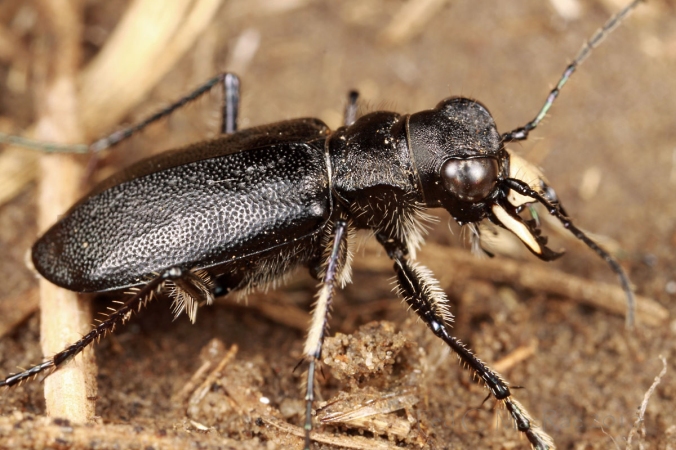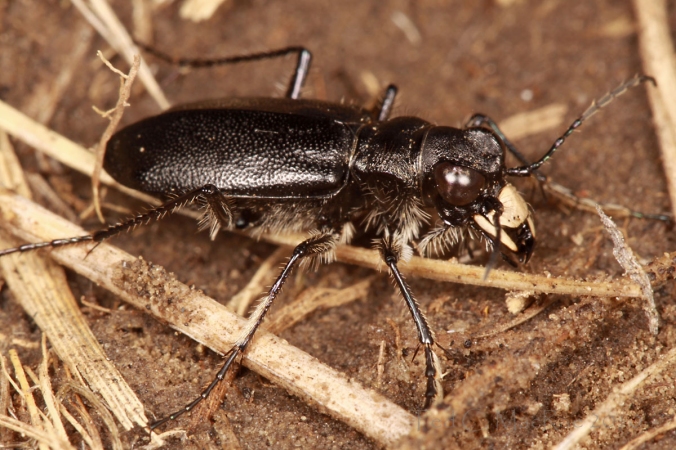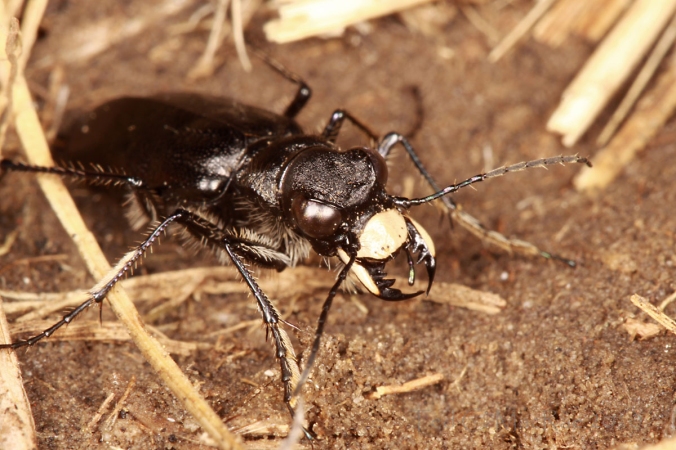We were only halfway through Day #1 of five days in the field and had already achieved Goal #1 of the trip. Despite that, it took a few hours before Chris and I were ready to tear ourselves away from our first stop in Fall River Co., South Dakota, where we were treated to the sight of glittering, wine-red adults of Cicindela pulchra bejeweling the charcoal-colored shale slopes. However, the list of species that we wanted to see over the next several days was long, and eventually our pulchra-fever abated (barely) enough to head south to the Pine Ridge in Sioux Co., Nebraska to look for A-list Species #2 – Cicindela nebraskana. Sioux Co., Nebraska is the type locality for this species (thus the name), but in reality it is a more western species whose distribution just barely sneaks into the northwestern corner of Nebraska (Pearson et al. 2006, Spomer et al. 2008). I first saw this species at this very site two years ago, seeing only a handful of individuals and managing one harshly-sunlit, point-and-shoot image of one of them. To my knowledge, this remains the only known field photograph of this species.
This time, with a Canon 50D camera and 100mm macro lens in my backpack, I was much better equipped for vastly improved field photographs, but in contrast to the numerous individuals of C. pulchra that we saw earlier in the day, only a single C. nebraskana would turn up after intensive searching by Chris, Matt Brust, and myself in the vast shortgrass prairie sitting at the type locality atop the Pine Ridge. I didn’t find it – Matt did – and the general rule with rare tigers is to capture the first individual rather than try to photograph it. If no others are seen, photographing it later in a terrarium of native soil is better than trying to photograph it in the field and risk letting it escape. Matt gave it to Chris, and at the end of the day when we realized we were not going to see another one, we prepared a terrarium of native soil, taking care to keep the surface as intact as possible so that an accurate replication of the field situation could be created when we photographed it later.
Although I prefer actual field photographs, the nice thing about photographing tiger beetles in confinement is… well, they don’t run away! That’s not to say it is easy. While they do settle down if left undisturbed for a while, once you start messing with them they quickly become agitated and start running in circles around the terrarium perimeter. Much finger prodding is necessary to get them away from the edge and into a good spot for photographs, and rarely do they stay put for long. When they finally do settle down, they tend to “hunker down” in a most unflattering pose (as above) – lacking the appearance of alertness that gives the true field photos their life.
I’m a persistent (syn. stubborn) sort, however, and I’ve learned that I can wear them down and poke and prod them out of their hunker. Just a light poke at the face will often make them back up and lift their front slightly – poke again and they often open their jaws half-cocked – a light touch on the tip of one antennae and they’ll turn slightly. With practice and patience, hunkered down beetles can be coaxed into some remarkably aggressive-looking poses. I like the last of these photos in particular because the oblique, jaws half-cocked pose shows off two nice features of this species – the quite long labrum (upper lip) compared to most other tiger beetle species, and the bright white labrum and mandibles of the males of this species (in females they are partially or completely dark). The long labrum and jaws give this species a very long-faced appearance that distinguishes it immediately from the black morphs of Cicindela purpurea audubonii that occur with much greater frequency in the same habitats as C. nebraskana.
Photo Details:
1: Canon 50D w/ MP-E 65mm 1-5X macro lens (ISO 100, 1/250 sec, f/13), Canon MT-24EX flash w/ Sto-Fen + GFPuffer diffusers.
2: Panasonic DMC-FX3 (ISO 100, 1/400 sec, f/5.6), natural light.
3-4: Canon 50D w/ 100mm macro lens (ISO 100, 1/250 sec, f/16), Canon MT-24EX flash w/ Sto-Fen + GFPuffer diffusers.
All photos: Typical post-processing (levels, minor cropping, unsharp mask).
REFERENCES:
Pearson, D. L., C. B. Knisley and C. J. Kazilek. 2006. A Field Guide to the Tiger Beetles of the United States and Canada. Oxford University Press, New York, 227 pp.
Spomer, S. M., M. L. Brust, D. C. Backlund and S. Weins. 2008. Tiger Beetles of South Dakota & Nebraska.University of Nebraska, Department of Entomology, Lincoln, 60 pp.
Copyright © Ted C. MacRae 2010




That second shot is terrific. You’re lucky he’s so small, cause he really looks like he wants to launch himself into the air to tear out your throat. 🙂
Thanks, Ken. The downward slant to the eyes adds a particularly menacing aspect to the look.
Ted, Great shots as always!
Thanks, Sam!
Hi Ted – snuck over while my work computer was rebooting – love the eyes on this guy. And I could see immediately why he is called “long-lipped.”
I wonder if the importance of native soils has to do with the bacteria/fungi in the soil that can make or break plants? Makes sense that it would similarly affect other organisms that live in the soil…
Thanks, Amber.
Most tigers are associated with soils that are relatively barren of vegetation, suggesting that physical factors such as pH, mineral composition, texture, salinity, etc. are more important.
Love the top photo. I especially like the shots that show the texture of the elytra.
Hi Doug. I didn’t really notice the elytral punctation until you mentioned it – that would be another character distinguishing the species from black morphs of Cicindela purpurea audubonii.
Great photos of C. nebraskana and C. pulchra, Ted!
John Acorn in his book Tiger Beetles of Alberta mentions that his very young son at the time, while looking at a head on photo of a tiger beetle, called it a “scare beetle”. Your last photo of C. nebraskana fits that description
quite well.
Thanks, Charlie. I’ve been trying to get some “scare beetle” photos of Amblycheila cylindriformis – those huge mandibles would be perfect for it. Unfortunately, they just keep running and hunkering down when I prod them and never seem inclined to get that PO’d look.
hola Ted soy de Argentina vivo en Carmen de Patagones hoy encontré en mi puerta una cicindela nebraskana soy profesora de ciencias naturales.Tengo una colección de insectos .
Hola lalu – bienvenidos, y gracias por visitar mi blog. Hay muchas especies de cicindelidos en Argentina que son bastante similares. La especie Cicindela nebraskana vive solamente en el noroeste de los EEUU – debe ser otra especies que ha visto en su puerta.
No he visitado el sur de Pcia. Buenos Aires, pero hay la posibilidad que en el mes que viene voy a estar en Fontezuela por 6-8 semanas.
entomologicamente el lugar donde vivo es bastante pobre. Mi marido era entomologo y cuando tenía aproximadamente tu edad capturaba insectos para la colección nacional.
tengo una colección intereante.
lamento no haber conservado el insecto lo solté en mi jardín. Sera un gusto recibirte si vienes por Carmen de Patagones.
Si lo ve otra vez el escarabajo, espero que puede conservarlo o tomar una foto.
Gracias por la invitacion.